IVDD surgery is often thought of as a last resort for dogs diagnosed with intervertebral disc disease. So when is IVDD surgery the best option? And why? In Part III of Dr. Julie Buzby’s series on IVDD in dogs, she resumes the story of Tango, a 4-year-old miniature Dachshund diagnosed with his first episode of IVDD. (For Parts I and II, please read IVDD in Dogs: Why It Happens and IVDD: Can a Dog Recover Without Surgery? ) By the end of this article, you’ll have a comprehensive understanding of IVDD surgery, IVDD surgery success rates, IVDD surgery costs, and what to expect after IVDD surgery.

After an unsuccessful attempt managing IVDD at home with medications and strict rest, my Dachshund patient named Tango and his mom were back at my office. The notes in his chart read, “Not walking after falling off bed.” I cringed inwardly and headed to the lobby.
There sat Tango with his mom. She was holding him tightly and crying. I gestured for her to follow me into an exam room, where she placed her beloved Dachshund gently on the table. He waddled like a seal—his chest elevated and his hind end awkwardly dragging behind. He clearly wasn’t moving his back legs.
Since I’d already performed a thorough physical and neurologic exam on Tango at his first visit, I skipped right to the heart of the matter. Did he still have what veterinarians call “deep pain?”
What is deep pain perception and why is it relevant to IVDD surgery?
To understand deep pain perception and IVDD, we need to take a look some canine anatomy. The spinal cord is like a superhighway of nerve fibers. Imagine strands of rope, yarn, and thread bundled together and running from the brain, through each of the vertebrae, to the lower back. That’s the spinal cord.
Certain fibers carry the impulses associated with conscious proprioception (sense of body position). Others carry the signals for motor function (the ability to walk). The smallest fibers carry the impulses for deep pain.
These deep pain fibers are the last to be impacted by a compressive force (i.e. a disc herniation) precisely because they are the smallest fibers. The fibers vary by diameter. This is why there is a predictable progression in what reflexes/responses an IVDD dog loses neurologically.
Conscious proprioception, carried on big fibers—the “ropes”—is lost first. Veterinarians test conscious proprioception by turning a dog’s paw over (knuckles down) and seeing how long it takes the dog to correct his or her paw position. A healthy dog will put his or her paw back down the correct way (pad-side down) almost immediately. Various neurological injuries can cause conscious proprioception to be delayed or absent.
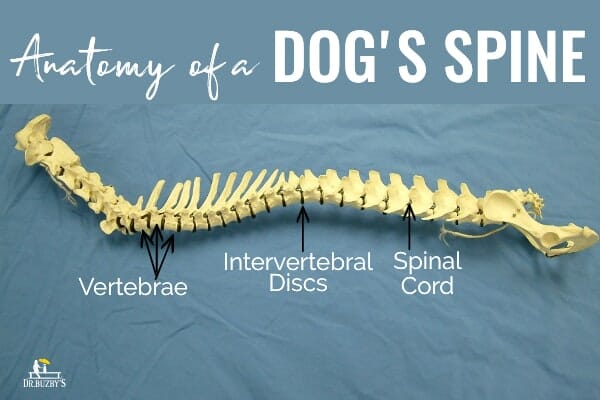
It runs from the brain through the vertebrae in the dog’s spine.
Loss of motor function—the “yarn” in my analogy—is next. When motor function is compromised, the dog can’t walk or move his or her legs.
The last sensation to go is the perception of deep pain, carried by the “thread.” Veterinarians test deep pain by tightly pinching a dog’s toes and gauging the reaction. This may sound mean, but it’s very important for us to know what degree of nerve damage a dog is experiencing.
The treatment plan and prognosis (expected outcome) are both based upon symptoms, which correlate to the fibers that have been impacted.
Distinguishing between Grade 4 & 5 IVDD
Veterinarians use a grading scale of one through five for IVVD dogs. The more severe the symptoms, the higher the grade. Grade 5 dogs represent the most critical cases.
Grading scale for IVDD in dogs:
- Grade 1 – Pain without neurologic deficits
- Grade 2 – Change in gait (ataxia) with delayed or absent conscious proprioception
- Grade 3 – Partial paralysis (called paresis); the dog is able to move the legs but not walk
- Grade 4 – Paralysis with deep pain perception present
- Grade 5 – Paralysis with loss of deep pain perception
The grade is a reflection of how badly the herniated disc is compressing the spinal cord. In many cases just the back legs are affected, but in some dogs all four legs are affected. This is dependent on where along the spine the injury occurs. The higher up toward the dog’s neck, the more likely the front legs are involved.
In the case of my patient having already lost motor function, Tango was a grade 4 or 5. But I needed to test his deep pain perception to know which one.
I took a hemostat out of the drawer and pinched one of his back toes, hoping desperately he could still feel them. His mom watched anxiously.
Tango let out a yelp when I tested both hind paws. His mom and I both breathed a sigh of relief as I rubbed Tango’s head to ask for forgiveness. I then gently felt his abdomen. His bladder was enormous—another sign of grade 4 or 5 IVDD.
I looked up and began explaining my thoughts to Tango’s mom. “He’s now gone from grade 2 to grade 4,” I explained. “But he can still feel his feet. It’s time for referral to a veterinary neurologist for IVDD surgery.”
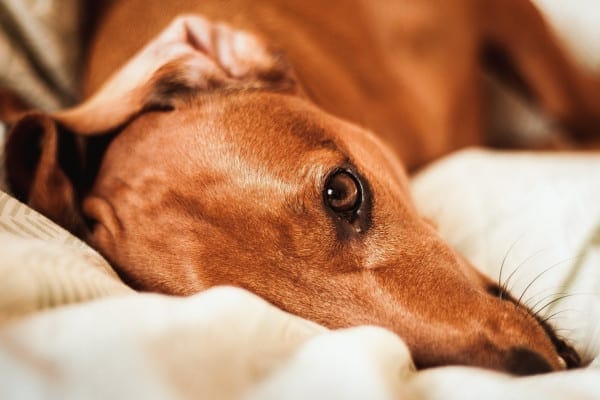
Why IVDD surgery is recommended
IVDD surgery is the recommendation for dogs who have lost motor function as a result of intervertebral disc disease. In fact, surgery is the gold standard treatment for any dog who has more than just pain symptoms (grade 1 IVDD). The prognosis with surgery for these dogs is significantly better than without surgery.
But I also appreciate that not every client can afford IVDD surgery. There is no judgment from veterinarians when clients cannot spend thousands of dollars for their dog to go to a referral hospital for back surgery. And in those cases, veterinarians do the best they can with medical management and home care.
Managing higher grade IVDD is certainly more intense than grade 1 or 2. Often, a dog with grade 4 or 5 IVDD has lost his or her ability to pee or poop unassisted. (This was why Tango’s bladder felt so big when I palpated his abdomen.)
In these situations, dogs need help voiding the bladder with manual expression several times a day. As the dog’s parent, you must maintain your dog’s fastidious hygiene to prevent him or her from developing urine scald and pressure sores. It is not an easy condition to manage, and I understand management may not be able to fit into everyone’s lifestyle.
If surgery is not a feasible option, and medical management is unsuccessful or not reasonably possible, you and your vet may sadly need to consider the option of euthanasia for your dog in the case of grade 4 or 5 IVDD.
IVDD surgery success rate
Studies have shown that surgical treatment for IVDD is successful in more than 90% of dogs with grade 1-4 IVDD. However, with grade 5 IVDD, success drops to only 50-60% if the surgery occurs within 24 hours of symptoms. For dogs who have surgery performed after the initial 24-hour window, the success rate drops dramatically.
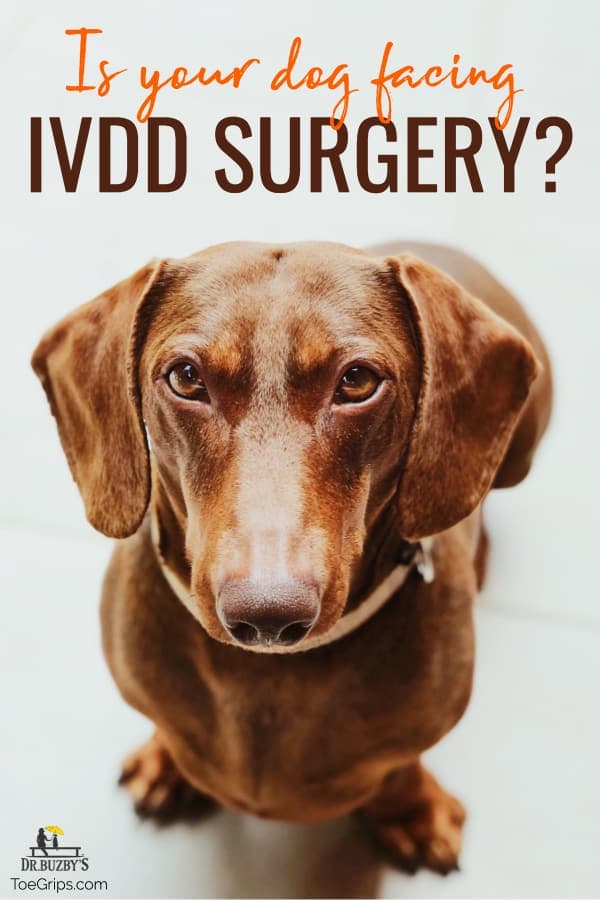
How much does IVDD surgery cost?
IVDD surgery cost varies based on common sense factors such as how extensive and complicated the surgery is and how long the dog remains hospitalized. Additionally, geographic location is one of the major factors affecting cost. The cost varies depending on the city, state, or geographic area of the United States where the surgery is performed.
While the actual surgical procedure may cost roughly between $1500-$4000, you must also take into account the hospitalization (aftercare), diagnostics such as imaging (X-rays, MRI, CT) and bloodwork, and medications. The total price tag for IVDD surgery ranges from approximately $3000 to $8000.
Planning ahead for IVDD
If you are the parent to a Dachshund or another breed that runs a high risk for IVDD, I recommend purchasing pet insurance or setting aside money before it’s needed to cover the cost of IVDD.
During Tango’s very first puppy visit, when he was just nine weeks old, I had discussed intervertebral disc disease with his mom. That may sound depressing, but we had talked about many other health and wellness issues like diet, dog tooth brushing, and dog nail trimming. Since he was a high-risk breed, I felt compelled to also go over the basics of IVDD. I suggested that my client consider pet insurance for her dog.
Instead of choosing pet insurance, my client created what she dubbed “The Tango Fund.” Every month she put money aside in case Tango ever needed IVDD surgery. Sadly, that day had come. But her foresight made the decision to say “yes” to my recommendation for surgery much easier.
Although it’s not ideal, if you can’t afford IVDD surgery, that doesn’t necessarily mean it’s the end of the road for your poor pup. There are options such as Care Credit if financing is a possibility, or you can discuss more medical management options with your vet.
Preparing for IVDD surgery
I made a phone call to our local neurologist to set up the surgery consult. Within 30 minutes of walking into my exam room, Tango was on his way to the specialty hospital for advanced diagnostics.
Before surgery, the neurologist needs to determine the location of the herniated disc(s). This can be done with several modalities including a CT scan, an MRI, or a myelogram.
MRI is the best way to look at soft tissue in the spine, but it is not always available. CT is a good method, as well, but also not always at hand. A myelogram is a contrast study using radiographs (i.e. X-rays). In this method, a dye is injected into the cerebrospinal fluid (CSF) around the spinal cord and then sequential X-rays are taken. This will show where a disc (or discs) is bulging and help the surgeon plan his or her approach.
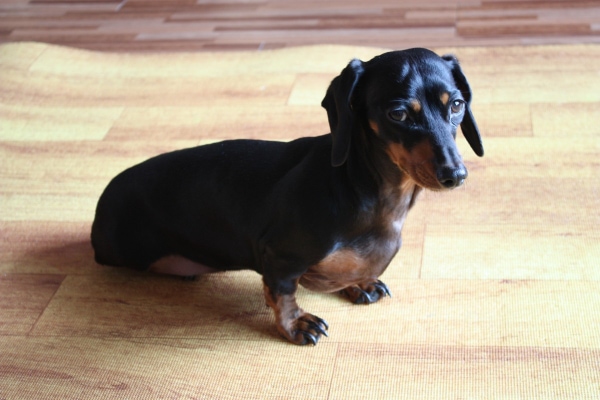
Types of IVDD surgery
Thus far, we have been referring to “IVDD surgery” as a general concept. But there are several types of IVDD surgeries, all with lovely, long, Latin-based names:
- Hemilaminectomy
- Pediculectomy
- Dorsal Laminectomy
- Ventral Slot
- Fenestration
The most common surgery for a herniated thoracolumbar disc is the hemilaminectomy. In this procedure, the articular facets (the joint surfaces between vertebrae) are removed and bulging disc material is cleared away from the spinal cord. If a disc in the neck has slipped, then the ventral slot procedure may be performed.
These are advanced surgeries that are always performed by a neurosurgeon. They require specialized equipment and excellent technique for a good outcome. (For more detailed information on IVDD surgeries, please read the Veterinary Medical Teaching Hospital at UC Davis’ article on disc disease.)
My Dachshund patient had an MRI which identified a disc bulging between his 11th and 12th thoracic vertebrae. He went to surgery, and the neurosurgeon performed a hemilaminectomy. The surgeon was concerned about the disc in front of and behind the herniated T11-12 disc, so he “fenestrated” those as a preventative measure.
In this procedure, a small window is cut into the “jelly donut” (described in Part I of our series), called the annulus fibrosus, and the “jelly,” called the nucleus pulposus, is removed. This, in theory, prevents spinal cord damage from future herniation of these discs.
What to expect after IVDD surgery
As you might expect, spinal surgery in dogs is a serious procedure and post-op care can take weeks to months. Typically, dogs stay in the hospital for three to ten days following surgery. Once a dog can urinate on his or her own and pain is well controlled, he or she may go home.
Convalescent care includes four to six weeks of restricted activity (crate rest—absolutely no jumping, running, stairs, etc.), administering anti-inflammatory medications, and sometimes antibiotics. In some cases, a sling may be helpful for supporting a dog’s back end during recovery.
Just like with any surgery, IVDD surgery aftercare includes incision care. Keeping the incision clean and dry, and monitoring for any signs of infection—redness, heat, swelling, or discharge—prevent incision complications. Typically, skin sutures or staples are placed over the incision and should be removed 10-14 days after surgery.
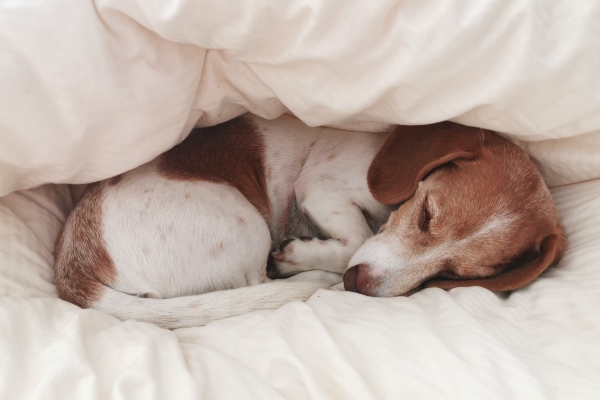
Physical therapy for pets is one of the fastest-growing aspects of veterinary medicine. Many veterinary surgeons will routinely prescribe physical therapy as part of the post-op plan for their patients because rehab can provide dramatic benefits. Additionally, rehab practitioners can teach dog parents to do simple techniques, such as massage and passive range of motion, as part of a home therapy program.
Alternative treatments that I’ve found to be very helpful include acupuncture and laser therapy. Supplements may also be added to conventional medications for possible anti-inflammatory benefits. My personal favorite is the combination of deer velvet and green-lipped mussel. I’ve had such good results with New Zealand deer velvet in my IVDD patients and in senior dogs that we now offer it through our website.
In fact, I recently received this note from a dog owner who tried New Zealand deer velvet for her Dachshund:
I have 2 short-haired Dachshunds: one is 11 years old and one is 5 years old. In late October, the younger one tweaked his back from jumping off the couch and was in a lot of pain for several weeks. He slowly got better after strict crate rest, Neurontin, and a muscle relaxant. Absolutely no long walks/exercise during this time. In early December, I went outside to look at the Christmas lights, and Oscar launched from the couch again. I forgot to put him in the crate and he reinjured himself. The cycle of multiple vet visits, strict crate rest, Neurontin, and a muscle relaxant began again. Oscar was getting very sad and tired of being in pain.
Then, it was recommended that I call Dr. Julie Buzby. Her advice was life-changing for Oscar. I tried the New Zealand Deer Velvet while he was recuperating with his daily crate rest. THE RESULTS WERE ABSOLUTELY INCREDIBLE. After 3 days of being on the Deer Velvet, Oscar’s sadness changed to happiness and he began to regain his normal activity level. He is now completely pain-free. No prescription medicines for his strained back (partially herniated disk) and he has resumed his 30-minute walks a day. My husband and I will continue the New Zealand Deer Velvet as a daily regimen for Oscar. He does have disk disease (as many Dachshunds do), so we are very grateful for this product to keep him pain-free and active for many years to come!” ~Jennifer Chastain
After his surgery, Tango spent three days in the hospital recovering. He had a urinary catheter in place so his bladder would stay empty because he couldn’t yet urinate on his own or walk.
This is a common scenario after surgery. Many dogs need several days to weeks for the swelling in the spinal cord to decrease. If everything goes as planned, movement will gradually come back to the legs during that time. The same is true for bladder control. In some cases, it can take one to three weeks for this to happen, and a dog might even go home with a urinary catheter in place.
How quickly will a dog recover following IVDD surgery?
The speed of recovery and the success of the surgery are dependent on the extent of injury to the dog’s spinal cord, the period of time between injury and surgery, and post-operative care. (To see the transformation IVDD surgery can bring about, check out the brilliant team at Southeast Veterinary Neurology, who shared the story of Buster, a dachshund who recovered from IVDD surgery.)
As you might imagine, the more severely the dog was affected by IVDD on our grading scale and the longer the time between injury and surgical decompression, the worse the prognosis (expected outcome). Thankfully, most dogs who have IVDD surgery recover normal function quickly. But severely affected dogs may be left with varying degrees of permanent damage.
Strict rest is incredibly important after surgery, as too much activity can lead to pain, trauma, and reinjury.
In the case of my patient, this time, Tango’s owner was prepared. She had his gabapentin for dogs, trazodone, and a comfy crate ready with his favorite snuggly toys. Also, she had purchased low-fat dog food, consulted with me about how many calories he needed per day to lose weight, and had decided no more bacon scraps.
Two weeks after his surgery, Tango was walking well again. He was able to control his bladder, and his mom had started him on his weight loss regimen. Tango’s story has a happy ending.

IVDD recurrence after surgery: Will IVDD strike again?
The good news is that most dogs who undergo IVDD surgery will not experience additional disc herniations. However, some will. (Dachshunds have been proven to have a higher risk of recurrence than other breeds.) The main reason Type I IVDD occurs in dogs is because of genetic factors which affect chondrodystrophic breeds. The abnormalities that predisposed one disc to bulge or herniate are likely present in other vertebrae.
But I’m a huge believer in being proactive and positively impacting what we can, which means making home modifications to try to maintain health and reduce high-risk behaviors such as running or jumping.
Making long-term home and lifestyle modifications following IVDD surgery
IVDD survivors may benefit from lifestyle modifications. I recommend the following to my clients. In consultation with your vet, you may also want to consider:
- Adding ramps or stairs for porches, beds, and other furniture to reduce your dog’s jumping
- Maintaining your dog at a healthy weight
- Engaging in low-impact, controlled activity/exercise only
- Changing from a collar to a harness for dogs with cervical IVDD (IVDD in the neck)
- Wearing Dr. Buzby’s ToeGrips® dog nail grips to prevent slips and falls while increasing stability, especially for dogs who struggle with slipping on hard surface floors. I recently received this note from a dog mom whose Dachshund is a ToeGrips® dog nail grips wearer:
Our 13 year old dachshund has been protected from the slippery hardwood floors for years using toe grips on his back paws. Just this year he needed back surgery, and his recovery was successful in no small part due to toe grips protecting him from slipping and sliding. A wonderful product!”
~ Francesca
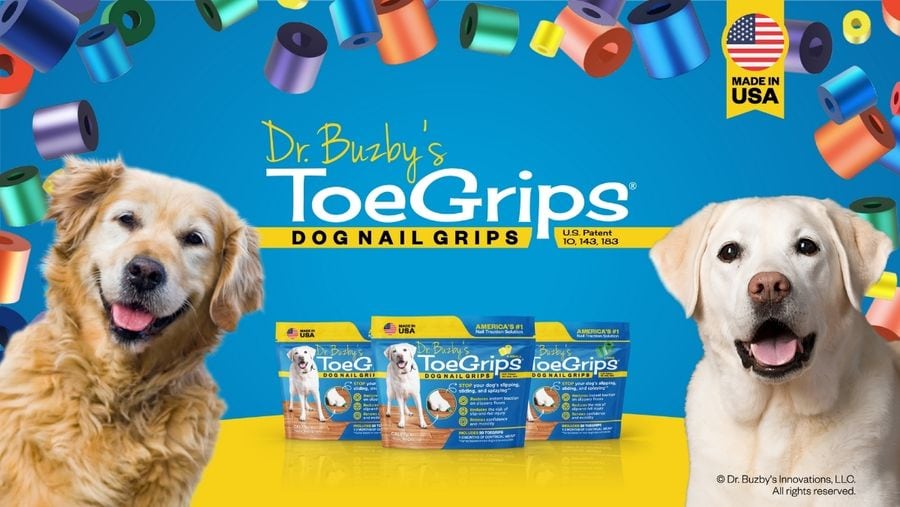
Conclusion
Finally, if your dog is being treated for IVDD, whether managed medically or surgically, the key is REST, REST, REST, AND MORE REST. I can’t emphasize enough the importance of crate training your canine companion from puppyhood. It is invaluable in case strict crate rest is ever prescribed for IVDD or any medical condition.
Most importantly, perhaps, is being aware and observant of your dog. At the first sign of back pain and weakness in your dog, seek veterinary care. And if your dog does have IVDD, remember—there are many treatment options! Maintaining close communication with your veterinarian is important.
What questions do you have about IVDD surgery for dogs?
Please comment below.


I Hi
I have a Shih tzu who just turned 4 years old. Saturday I noted she was not her normal self when I get home. Usually she is a happy girl and jumping around while barking for my attention. Then on that day I noticed that she has no energy. She said hello but was not excited. I also notice that she is shaking. I thought it was because of the weather (she tends to get cold easily) There are few occasions that we noticed she yelps (just one quick yelp) but we are not sure if it’s because the way we carry her because if I tried carrying her again on the same position that she just yelped she is no longer yelping.
Sunday came, and we notice we didn’t see her go out to pee or poo. So my husband had to bring her out, and she did relive herself.
Monday I notice she can’t jump on the couch where she spends her days when my husband and I have to work. On that same day around afternoon I brought her to the vet, and that’s the time the vet informed me she have IVDD after some xrays
I wasn’t aware of how bad it is yet. He informed me he gave her some shot for the pain and that she will be lethargic (and she is until we got home) the vet gave us the gabapentin and carprofen tablet ..
Tuesday I notice how wobbly she is when she walks. I got worried. My husband said that it’s the gabapentin effect on her.
Wednesday her Wobblies got worse where she gets to fall down then at the evening she is drugging her hind legs. We brought her to the ER, and they said more about the IVDD …. They said that her hind legs can still feel pain, or she can still move it..
They are suggesting the surgery right away which is around $12k to $16k with CTscan, MRI but the vet added that It still can go up. But we don’t have that much of money unless we applied on carecredit.
Today I have to support her hind legs to pee and poo… she’s eating great. I’m trying to make her rest good even if she’s trying to say hi. She seems more awake since Wednesday.
I’m thinking, where should I take the risk? And what should I do? Should I get her the surgery? Is the conservative treatment too late for her?
And she was walking and running fine aside from weak/sick and those little yelp before she became paralyze. I was thinking it was just because of the side effect of gabapentin that she is taking..
Should I try stopping her gabapentin? It just so hard to trust those people from the Vet/ER/Neurogist without thinking that the decision they are suggesting is for my dog’s best interest and not theirs… I’m such a wreck for two days now. I just keep crying and thinking the way I can help my beloved dog.
Hi,
What a stressful few days you have had. The progression of signs you described does unfortunately sometimes happen with dogs with IVDD. Others don’t seem to progress past the painful but mobile stage, and it is hard to know what will happen with each dog. Gabapentin can definitely cause some sedation and wobbliness during the first few days that a dog is taking it, so it would have been reasonable to assume at first that the signs you were seeing were medication side effects rather than progression of the IVDD. You did the right thing by bringing her in for evaluation at the emergency vet when the symptoms worsened. Generally, if you are going to do surgery, the sooner you do it, the better the outcome because it takes the pressure off the spinal cord sooner. That being said, I absolutely understand that CT/MRI and back surgery isn’t always financially possible or financially wise for many people. If that is the case, then I tell them to give it their best go with conservative treatment and see what happens. Strict cage rest, anti-inflammatory medication, muscle relaxers, physical therapy and adjunctive therapy like acupuncture or laser therapy can sometimes work wonders. I’ll link a few blogs below that might be helpful for you.
Best of luck to you and your pup!
1. IVDD: Can a dog recover without surgery?
2. Could Acupuncture for Dogs Help my Senior Dog?
3. Laser Therapy for Dogs: What You Need to Know
4. Dog Crate Rest: 9 Tips for Success from a Vet (Plus 5 FAQs)
I found your article exceedingly helpful. My 3 yo frechie jumped off the bed last Thursday, his left arm landing on a small toy ball. ER completed a neurological exam recommending surgery and giving me meds. I took the weekend to process the news when I initially came across your articles. I took him back today requesting an mri as I do not know the phase much less the type of surgery. They took yet another neurological exam only 2 days following the first, this time by the neurologist not ER. He’s improved with movement on one hind leg and weakness on the left when he was previously lame and stuff with a hyper extended neck stretching up. He’s now moving his neck and can use his functioning arm and leg to move about his bed, repositioning himself, although still unable to stand or walk. I’m worried I’m being rushed into surgery. They tell me it’s best to act quickly or it will cause more nerve damage. In the end, I had no mri today. They took blood prepping for surgery, advising me to drop him off tomorrow morning. They’ll conduct the mri and if decided they’ll proceed with surgery. They’ll call to inform me. I feel hesitant feeling as though options are not being discussed. Should I be concerned? Reviewing your info I believe he’d be a stage 4. I’m so worried about him going into such a huge surgery tomorrow without a proper review of his mri before hand. Should I just trust them to make the right decision?
Dear Christina,
I am so sorry your Frenchie injured his back and is facing this difficult situation. Without being able to examine him myself, I would have to defer to the expert recommendations from the specialist. How did things go? Did they end up performing the surgery? Hoping your boy is showing improvement and you are at peace with the decisions that have been made. Feel free to leave an update and let us know how he is doing. Praying for healing and that he can make a full recovery.
hi there,
my 5 year old sausage had idvv surgery 9 days ago and was doing well with lots of rest, temezepam, anti inflamatories and paracetomol. peeing pooing on demand.
physio 4× daily from us. now the meds have finished shes very active and keeos dragging herself around her crate using her back legs slightly.
is this bad?
shes seems to active and we cant leave her for even 1 minute as shes trying to climb the crate with her muscular front legs.
will this impede her recovery?
should she possibly have more medication to slow her down a bit?
or should we allow her to drag herself around?
since off the meds shes refusing drinks as well although eating well…despite us trying many tricks and adding boiled chicken water etc!
many thanks
Hi Ruth,
It sounds like you have one determined little dog! I would recommend reaching out to the surgeon and seeing if he or she wants to keep your pup on some of the meds a bit longer to help her rest and recuperate. It sounds to me like she might be being a bit more active than we would like at this point in her recovery, but since I wasn’t the surgeon, I can’t say that for sure. In addition to potentially giving her some more calming medications, you may want to try some of the tricks for crate rest that you can find in this article: Dog Crate Rest: 9 Tips for Success from a Vet (Plus 5 FAQs). I hope she makes a full recovery and is back to her usual self soon!
Hello,
We have a 3.5 yo beagle who on Saturday night was yelping and wobbly. Sunday AM she was in the ER. The vet said she might have hurt her back and to give her pain meds. By 9am the next day, her lower limbs weren’t working. She had no deep pain sensation – so by 5PM that day she was in surgery. They removed things from her spine and found a lot of swelling. She is home with us now and it’s 5 days post surgery. No movement on lower limbs or pain sensation. No bowel or bladder control which we’re doing manually.
Is there any chance of improvement five days post surgery? Is there anything else we can do? Another xray or diagnostic? We don’t want to keep her in pain and will have to make the unthinkable decision if we have to.
We’re still in shock how this happened so fast. Would like to learn more.
Thanks,
Julie H and family
Dear Julie,
I am so sorry your Beagle suffered this tragic injury to her spinal cord. While there is still hope, it is a strong possibility you may have to make some very difficult decisions about her quality of life. I will attach links to other articles with more information about this terrible condition. Wishing you strength and comfort and praying for a miracle for your sweet girl.
1. IVDD in Dogs: Why it Happens
2. IVDD: Can a dog recover without surgery?
3. IVDD in Dachshunds: Lady Penelope’s Experience
Hello…i have a 4.5-year-old French bulldog that went down suddenly with IVDD on both hind legs. he was taken immediately to the vet where he then went into surgery a few hours after being diagnosed, grade 5. This was in late January. After 4weeks of crate rest, he started acupuncture, red laser therapy and most recently the water treadmill was added to his weekly rehab schedule. He is exhibiting ‘kick’ reflexes in his back legs, one side is stronger than the other, and is standing for around a minute or so but rather stiff legged. I would like to know your thoughts for what we might concentrate on for the future – we have seen some minor improvements but certainly nothing dramatic to indicate that he might walk again in some fashion, or is it just too early still….
Hi D,
I am so sorry your young pup has endured this severe injury to his spinal cord. There is definitely hope for more improvement, these types of issues just take a long time to heal. Of course, there is no guarantee he will regain his mobility and we don’t know what degree of function he will be able to attain. It may be a good idea to look into getting him a cart or wheels for his back legs. This way you can still offer rehab, but your pup can have a sense of independence and improve his quality of life in the meantime. Joint supplements are a great idea as well, especially if you can include deer antler velvet. Here is a link to an article with more information: Deer Antler Velvet: The Science Behind the Supplement
Hoping your sweet boy can keep fighting and praying for his healing. ♥
Hello,
My 13 year old shih tzu is currently 3 weeks into recovery from IVDD surgery. He was stage 5 and had 4 disks operated on (1 being considerably bad). He still has his catheter in place and is still unable to walk but I am noticing that his kicks are getting stronger when I tickle his paws. His tail is also beginning to curl around my fingers when I stroke him, none of this was happening 1/2 weeks ago. Could this be an improvement or is this likely to be reflexes?
He is still happy within himself, eating and drinking lots. I am waiting now on his catheter to come out again before thinking about next steps. I am willing to do whatever it takes to give him a happy life if I can.
Hi Mairi,
I am so sorry your boy has endured this painful condition but glad to hear that the surgery was successful. What you are describing does sound like he is regaining feeling in his legs. Those are not typical “reflexes” we assess in dogs. I strongly encourage you to seek out the services of a veterinary rehabilitation professional. They can help your boy regain strength and mobility and guide you along the road to recovery. Praying for continued healing and for many happy days ahead for you both.
My five year old doxie girl has intermittent issues with her right front leg – limping and non weight bearing. She has been checked by two vets who can’t find an issue. She has been in 2 – two week courses of 25 mg rimadyl twice a day. As long as she is on the rimadyl she is fine but about 24 hours after she goes off it – she starts limping again. Could the rimadyl be masking Ivdd issues? She has no problems with her other legs, isn’t knuckling or arching her back.
Hi Jane,
I am sorry your Dachshund is having these recurring issues with limping and pain. Yes, the Rimadyl could be decreasing the inflammation associated with IVDD and masking any symptoms. It sounds like it may be time to do some further investigation. Has your vet taken any x-rays? If not, that would be a great place to start. I would try to rule out any abnormalities in the leg and also take a peek at the spine to see if IVDD is obvious. Just know that IVDD deals with the soft disks in-between the vertebrae of the spine. While x-rays are great for evaluating bone, it can be less than ideal when looking at soft tissue. This is why IVDD may not show up on routine x-rays (unless there is compression or widening of the spaces between the vertebrae) but can be clearly seen with MRI or CT. If you want more details or need an expert opinion, I encourage you to schedule a consultation with a specialist. Hoping you can find the best way to give your pup some relief. Best wishes to you both!
My 11 year old dachshund was diagnosed with a slipped disc in her neck last week. She has progressed rapidly and is losing function in her front leg. Unfortunately she also has congestive heart failure stage 3, diagnosed last august, so surgery is not an option due to the high risk category she’s in. She’s being kept comfortable on pain meds and anti-inflammatory meds but we are pretty sure we know where this is headed. My question is how much longer should we continue this process without causing her discomfort and without causing other issues.
Hi Brittany,
I’m so sorry to hear that your dachshund’s cervical IVDD is progressing and that she isn’t a good candidate for surgery. While I’m sure it is incredibly difficult, I applaud you for thinking about her quality of life going forward and for striving to make the best decisions possible for her. Since I haven’t gotten the chance to meet or examine your dog, I can’t give you a concrete idea of if her IVDD will continue to progress or if it will stabilize or improve. However, your vet may be able to give you some idea of what to expect. Also, it may help you to do a quick assessment of her each day so you can see how things are changing. This could be filling out a quality of life scale (see link below) or something as simple as marking a calendar with some observations (including her pain and mobility) each day. It is clear that you love her a lot, and I’m convinced that you will be able to make the right decision for her, whatever that ends up being. ❤️
Here is the link I mentioned:Using a Quality of Life Scale for Dogs
My dachshund just was diagnosed with
Cervical IVDD. Just 72 hours ago we thought we would have to put him down. He is mostly in stage 1 as he is in pain but he is still eating and going to the bathroom and can walk. My question is how well do dogs who have cervical ivdd recover? He is already acting better as he has been on strict kennel rest, carrying him in and out to use the bathroom as well as keeping up on his medication. Is there a chance he will be 100% back to running and playing like his normal self? I know we will need to take precautions, but will he eventually be able to get off medication?
Hi Devin,
I understand your concern for your Dachshund with this recent IVDD episode. Each case is different and there is really no way to make specific predictions about how the recovery process will go. There is definitely a chance he can return to 100% function! I have seen this many times with my own patients. I don’t think cervical IVDD has any worse a prognosis than IVDD in other regions of the spine and should act very similarly. There is also a good chance that your dog could discontinue medications for pain and inflammation, but I would recommend continuing a high-quality joint supplement for the rest of his life. I hope this helps a bit. Praying your sweet pup will be able to make a full recovery and have a very happy future.
My 5 year old American Staffy just had surgery to remove herniated intervertebral disk material within his spinal canal. He had to have this done as he was in excruciating pain. The operation went well and his recovery is amazing. But very hard keeping him confined as he is feeling well. My question is with regard to when he is fully recovered. Can he use stairs again ? My house has a lot of stairs and moving is not an option. Would he be able to do all things he could do before the surgery ?
Hi Caroline,
I am so glad your Staffy’s surgery was a success and recovery is going well! Without examining your guy, myself, it is hard to make specific conclusions about what to expect further down the road. It is possible he can return to normal function and activities. This would be a good question for the surgeon or a veterinary rehabilitation professional. They can assess your dog’s level of function and review his x-rays and let you know how to proceed and what activities are safe.
when you say the success rate with surgery drops to 50 to 60% with a grade 5, does this mean 50% of dogs make a full recovery or that they may recover but still have problems and need lifelong care?
Hi Joanne,
This means that 50% of the time the dog will be able to walk again but may still have problems and may require special assistance/support. It can still occur again at a different location along the spine and the pet may have to use long term medications. They also usually require changes to their lifestyle such as no more jumping, climbing stairs, etc. I hope that clears things up a bit. Thank you for reaching out!
My dog had deep pain sensation prior to having hemilaminectomy surgery.. he had the surgery about 1 pm on Christmas Eve. When he was checked at 9:00 am the next morning, he was neurologically worse, No deep pain.
His surgeon said there is a possibility of post surgical swelling causing this.
We feel devastated that he will never walk again or have bladder control. At what point post surgery should he have deep pain sensation to give him hope of walking again. Or is it already looking grim for his recovery?
Dear Lor,
I am so sorry you are in such a difficult situation with your dog. With post-op complications like this, there really is no magic number for how long to wait for results. Each dog is very different, and things can change quickly from day to day. How is your pup today? I am praying he was able to make a miraculous recovery and is still with you. Feel free to leave an update if you have a chance.
I have a 9 year-old Frenchie (Betty) with IVDD. She still has sensation in her back paws and can occasionally stand but is unable to walk.
It has been determined that she will need neurosurgery to correct this disc issue – and will need an additional procedure (to be performed by a general surgeon (rather than a neurosurgeon) while under anesthesia to stabilize her spine, utilizing 3D printed drill guides.
Here’s the problem: the veterinarian/neuro team that is overseeing these processes does not communicate with me, and I just learned that the surgery cannot be scheduled until the end of December at the earliest.
I am concerned that Betty’s condition will further deteriorate in the meantime. She has had radiographs, an MRI and is currently taking steroidal and pain medications. We have an appointment with a physical therapist who will perform an assessment and issue a treatment plan.
Would she be a candidate for your surgical services – and do you have a surgeon who could perform the spine stabilization?
Many thanks,
Tana Mitchell
Hi Tana,
I understand your concern with Betty and her need for surgery. Unfortunately, this type of procedure can only be done at a specialty/referral practice or teaching hospital/veterinary school. Most clinics are back logged with appointments and surgeries, and you would probably run into this same situation no matter where you go. I know the end of December seems very far away and a lot can change in that amount of time. This still may be your best option to give Betty the best chance at a full recovery. I think getting started with a physical therapist is a great idea. Hopefully this will be able to keep Betty’s condition stable until her surgery date arrives. Wishing you both the best and feel free to leave an update if you have a chance.
Hello,
Our otherwise absolutely healthy 15-year old pug has IVDD and stopped be able to stand on his back legs in April. Our vet is not recommending IVDD surgery in terms of risk and results, but I we are doing acupuncture and looking at supplements. I would like to try your Encore Mobility product (as long as it is not made in China). Any other thoughts?
Hi Philip,
I am sorry your senior guy is not a good candidate for surgery. I hope the acupuncture has been helping with the pain during his recovery process. I highly recommend you talk to a veterinary rehabilitation/physical therapy specialist. They can help reduce pain and inflammation and allow your pup to regain strength and muscle control in his back legs. They can also give you realistic expectations on what outcome is possible for your dog’s specific situation. Also, Encore Mobility is made in New Zealand due to the Deer Antler Velvet that is part of the supplement. Here is an article with more information: Deer Antler Velvet: The Science Behind the Supplement
Best wishes!
My 4 year old Rat Terrier/Dachshund mix has just been diagnosed with a herniated disk in his neck. He can still walk and control his bladder, but back legs are weak and urinating is in a zigzag line instead of a puddle. We are treating it medically with anti-inflamatories, muscle relaxer & pain meds & crate rest. He seems to be comfortable. Do you think he will be prone to more incidents of this once he recovers? Is this a genetic problem because of his 1/2 dachshund breed? We were hoping a mutt might have better luck than a purebred, but maybe not. Thanks for your opinion.
Hi Donna,
I am glad to hear your little guy is doing ok with the medical management of his IVDD. Unfortunately, yes, he will have a higher probability of another disk herniation. Also the same disk that is causing his current issue can flare up again in the future. Any dog can get IVDD but I would think that since he is half dachshund, he is in a higher risk category. I hope your sweet boy continues to heal quickly and has a long happy life ahead.